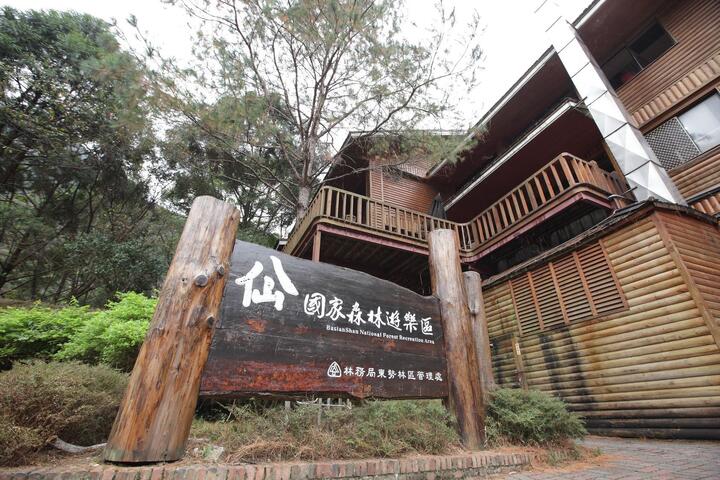Bashan Mountain National Forest Recreation Area Introduction
Ba Xian Mountain Forest Recreation Area is located in the Heping District of Taichung City, with its main peak standing at an elevation of 2,366 meters, approximately 8,000 Taiwanese feet, hence the name "Ba Xian" (Eight Immortals). The area is covered with lush forests and enjoys a refreshing and pleasant climate, where the Shiwen River and Jiabao Creek converge. The water sourcing from deep mountain forests is crystal clear, and stones of various sizes are scattered throughout the creek, creating a constant flow of water. The rich natural ecological resources and its history as one of Taiwan's three major logging areas provide a rich forestry culture, making it an ideal place for relaxation and experiencing nature on weekends! The Ba Xian Mountain Forest Recreation Area is located within Taichung City’s Heping District, with elevations ranging from 700 to 2,938 meters, encompassing Ba Xian Mountain and Ma Lun Mountain, among others. The area is situated on the alluvial terrace where Jiabao Creek flows into the Shiwen River, and the water quality of the two streams is clear and abundant. The Shiwen River valley is magnificent and picturesque, with bizarrely shaped rocks in the stream; the white and gray-green boulders appear irregularly arranged, allowing visitors to momentarily forget the mundane world. The azure waters flow past the giant rocks, creating white foamy waves, and the verdant surrounding forests give a pure and simple feeling, leading to a sense of isolation from worldly affairs. Currently, the Ba Xian Mountain area is predominantly represented by plants such as Pinus taiwanensis, Taiwan fir (Cunninghamia lanceolata), Chamaecyparis obtusa, and plants from the Fagaceae family. Pinus taiwanensis is distributed on landslide areas and sunlit slopes that have been developed, as it contains a large amount of resin, making it highly susceptible to forest fires. Taiwan fir is mostly found on ridge tops, and the Taiwan firs in Ba Xian Mountain are of considerable age, indicating their long presence in the Shiwen River basin. Landslide areas gradually become inhabited by pioneer plants like Calamus and others, and in moist, foggy environments, large rocks are also colonized by numerous ferns: the black-stemmed fern (Dipteris conjugens), the cup fern (Gleichenia japonica), and various species of wood ferns, becoming the most common species in this area. Under the "pioneering species'" expansion, some Lauraceae, Annonaceae, and Fagaceae plants gradually join to form second-growth forests, slowly covering the landslide areas. At this time, some climbing plants like Cinnamomum camphora, Smilax spp., and other vines begin to invade the spaces within young trees. With a "plentiful" environment provided by plants, insects also gradually invade this newly formed forest, attracting birds that feed on insects and plant fruits, such as Parus monticolus, Parus major, Cyanopica cyana, Cisticola juncidis, and other birds, especially notable species that migrate down from high-altitude regions in winter, making this valley even more lively. This trend makes Ba Xian Mountain Forest Recreation Area, situated beside the Shiwen River, one of the best places in central Taiwan for ecological observation. The geology within the recreation area mainly consists of fragile sandstone, slate, and hard rocks. Due to the erosion and cutting of the Shiwen River, the terrain is quite steep and has not been excessively disturbed, making the water quality exceptionally clear and the ecological resources richer. Every autumn, many red frogs (Hoplobatrachus rugulosus) that grow in the forest floor go to the Shiwen River to participate in the annual group wedding, and once the tadpoles grow into juvenile frogs, they migrate back to the forests. In the Shiwen River, one can also spot kingfishers, gray-breasted waterhens, Taiwan whistling thrushes, river terns, green herons, and little forks, with almost all the stream-dwelling birds congregating here. The development of Ba Xian Mountain began among the precious cypress forests shrouded in fog. In 1911, due to its elevation of nearly 8,000 Japanese feet (7,998 Japanese feet, about 2,410 meters), the Japanese originally intended to name it "Ba Qian Mountain," but later opted for the more elegant name "Ba Xian Mountain." However, overall development began in 1914, instructed by the Bureau of Forestry under the Japanese Governor-General's Office, prompting surveys to develop logging in the region for cypress, incense cedar, and fir, with a planned logging area of about 14,600 hectares, including Ba Xian Mountain and Bai Gu Mountain. The following year, a Bureau of Forestry was established under the Governor-General’s Office, leading to the separation of Ba Xian Mountain's forestry operations from the Alishan operations and reorganization under the Bureau of Forestry. A forest railway was constructed from Fengyuan into the Ba Xian Mountain area. During the logging peak, many lumberjacks resided in the area, building schools, lodges, offices, shrines, and effectively creating a small community. In the past, Ba Xian Mountain logging area was ranked alongside Alishan and Taiping Mountain as one of Taiwan's three major logging areas. After Taiwan's retrocession, it was renamed Ba Xian Mountain Logging Area and continued forestry operations. It wasn't until the 1980s, after all logging activities ceased, that Ba Xian Mountain began shifting towards recreational tourism development, leading to the establishment of the forest recreation area. Consequently, the elementary school, shrine, and other structures have vanished due to earthquakes and the passage of time, while the forest railway connecting Ba Xian Mountain to Fengyuan has gradually disappeared due to landslides and years of neglect, becoming a historical memory for the local residents. Nature is always undergoing succession. Each year, Taiwan faces the trials of typhoons, earthquakes, and other natural disasters, an ongoing fate of its ecological cycles, and a mechanism that contributes to Taiwan's biodiversity and richness. A careful observation within the Ba Xian Mountain Forest Recreation Area allows one to deeply appreciate these intricacies, which is one of nature's most profound gifts to the people of Taiwan. (Excerpt from Ba Xian Mountain Forest Recreation Area official website)










































